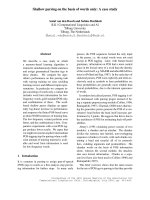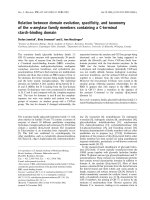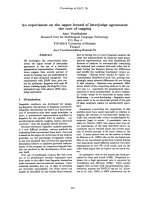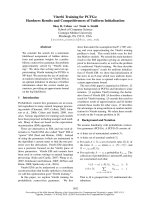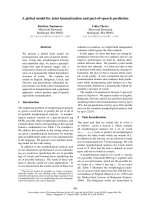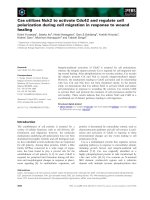Báo cáo khoa học: "First observations on the root morphology and symbioses of 21 major tree species in the primary tropical rain forest of French Guyana" pps
Bạn đang xem bản rút gọn của tài liệu. Xem và tải ngay bản đầy đủ của tài liệu tại đây (1 MB, 10 trang )
Original
article
First
observations
on
the
root
morphology
and
symbioses
of
21
major
tree
species
in
the
primary
tropical
rain
forest
of
French
Guyana
M
Béreau
J
Garbaye
1
INRA,
Station
de
Recherches
Forestières,
Groupe
Régional
de
Guyane,
BP
709,
97387
Kourou
CEDEX,
French
Guyana;
2
INRA,
Centre
de
Recherches
Forestières
de
Nancy,
54280
Champenoux,
France
(Received
15
June
1993;
accepted
2
December
1993)
Summary —
A
wide
diversity
of
root
morphology
and
symbiotic
associations
have
been
catalogued
in
21
tree
species
in
the
tropical
rain
forest
of
French
Guyana.
Some
unusual
structures
are
described,
such
as
nodular
short
roots
containing
hyphal
coils.
Endomycorrhizal
symbiosis
prevails
in
this
type
of
forest.
Parasitic
nematodes
(Meloidogyne
sp)
on
young
seedling
roots
of
Dicorynia
guianensis
and
Pelto-
gyne
venosa
probably
interfere
with
their
regeneration.
tropical
rain
forest
/
Caesalpinioideae
/
root
type
/
symbiotic
status
/
French
Guyana
Résumé —
Premières
observations
sur
la
morphologie
des
racines
et
les
symbioses
racinaires
de
21
espèces
principales
d’arbres
en
forêt
tropicale
humide
primaire
de
Guyane
française.
Dans
la
forêt
tropicale
humide
de
Guyane
française,
une
grande
diversité
de
morphologie
racinaire
et
d’associations
symbiotiques
a
été
observée
sur 21
espèces
d’arbres.
Certaines
structures
inhabi-
tuelles
sont
décrites,
comme
des
racines
courtes
noduleuses
contenant
des
hyphes
en
pelotons.
Les
endomycorhizes
constituent
l’association
symbiotique
dominante
dans
ce
type
de
forêt.
Des
galles
à
nématodes
(Meloidogyne
sp)
fréquentes
sur
les
racines
des
semis
de
Dicorynia
guianensis
et
de
Peltogyne
venosa
jouent
probablement
un
rôle
dans
la
régénération
de
ces
espèces.
forêt
tropicale
humide / Caesalpinioideae / morphologie
racinaire
symbiose / Guyane
française
INTRODUCTION
The
primary
tropical
rain
forest
of
French
Guyana
has
been
extensively
studied
for
its
structure
and
regeneration
dynamics
(Riera
et al,
1990;
Sabatier and
Prevost,
1990).
Most
previous
studies
have
con-
cerned
the
part
of
the
stands
above
ground,
and
little
attention
has
been
paid
to
the
inter-
actions
between
trees
within
the
soil.
This
should
be
an
important
part
of
any
modelling
of
the
spatial
distribution
of
species
and
their
regeneration
patterns.
More
generally,
very
little
is
known
about
the
rooting
habits
and
symbiotic
status
of
trees
in
the
neotropics
(Souza
Moreira
et al,
1992).
The
occurrence
of
different
types
of
root
symbioses
and
parasitism
seems
to
be
par-
ticularly
relevant
in
this
respect,
because
symbionts
determine
different
modes
of
nutrient
mobilization
and
uptake,
and
par-
asites
can
alter
the
efficiency
of
roots.
More-
over,
the
spatial
distribution
and
dispersive
mechanisms
of
microbial
symbionts
or
par-
asites
might
contribute
to
the
complexity
of
those
mechanisms
in
trees.
This
paper
presents
some
preliminary
descriptive
results
showing
the
wide
diver-
sity
of
root
morphology
and
their
symbiotic
or
parasitic
status
in
this
type
of
rain
for-
est.
We
also
discuss
some
unusual
struc-
tures.
MATERIALS
AND
METHODS
The
observations
were
carried
out
in
3
sites
that
are
relatively
close
to
each
other
(ca
20
km
apart,
centred
around
Sinnamary,
5°
20’
N,
52°
50’ W,
110
km
west
of
Cayenne
on
the
Atlantic
coast).
These
sites
are
representative
of
the
wide
diver-
sity
of
soil
conditions
and
forest
structure
pre-
vailing
in
the
region
and
are
found:
-
along
the
Saint
Elie
track
in
the
ECEREX
research
zone
(Sarrailh,
1984).
The
soils
here
are
developed
on
the
Bonidoro
shales
(Boulet,
1990);
-
in
the
experimental
plots
of
Paracou
(Bariteau
and
Geoffroy,
1989).
The
soils
here
are
devel-
oped
on
migmatite
and
shales
(Boulet
and
Brunet,
1983);
-
along
the
Anse
de
Sinnamary
road
on
a
sandy
detritic
coastal
flat.
Table
I lists
the
21
tree
species
observed.
They
were
chosen
from
13
families
(among
the
68
in
French
Guyana),
which
include
61%
of
the
species,
and
for
their
economic
importance
(more
than
half
provide
valuable
timber).
Some
species
are
economically
interesting
or
putatively
ecto-
mycorrhizal,
according
to
their
taxonomic
posi-
tion
(the
sub-family
Caesalpinioideae
in
the
Legu-
minosae)
and
to
other
studies
in
Africa
(eg,
Alexander
and
Högberg,
1986;
Fassi
and
Moser,
1991).
The
Caesalpinioideae
sub-family
is
the
dominant
group
of
trees
in
the
Guyanas,
in
diver-
sity,
density
and
biomass
(Puig
et al,
1990).
The
species
Dicorynia
guianensis,
Peltogyne
venosa,
Sclerolobium
melinonii,
Eperua
falcata
and
E
grandiflora,
Hymenea
courbaril
were
thus
more
extensively
sampled
at
the
seedling
stage
(>
100
individuals).
Sampling
was
performed
all
year
long,
on
either
roots
of
mature
trees
(roots
were
traced
from
the
base
of
the
tree)
or
seedlings
at
different
distances
from
the
corresponding
mother
trees.
Fine
roots
were
carefully
washed
and
observed
fresh
under
the
stereomicroscope.
Putative
ecto-
mycorrhizas
were
examined
following
the
methods
described
by
Ingleby
et al (1990).
Hand-cut
sec-
tions
and
crushed
roots
were
observed
unstained
under
the
light
microscope
(500
x).
Part
of
the
fine
roots
were
cleaned
and
stained
according
to
the
technique
described
by
Phillips
and
Hayman
(1970)
for
the
observation
of
endomycorrhizas
with
the
light
microscope
(120
x -
500
x).
The
occasional
presence
of
sporocarps
of
putative
ectomycorrhizal
higher
basidiomycetes
was
noted.
RESULTS
The
general
architecture
of
the
fine
roots
varies
greatly
in
both
diameter
and
branch-
ing,
from
0.3
mm
and
a
very
dense
mat
of
fine
roots
for
D
guianensis
and
P
venosa
(fig
1),
to
1
mm
and
a
poorly
branched
sys-
tem
for
E
falcata
(fig
2)
and
E
grandiflora.
The
length
distribution
of
fine
roots
is also
variable,
from
very
short
roots
(0.5-5
mm,
fig
2)
on
long
axes
(10
cm
and
over
with
no
long
laterals)
for
the
2
Eperua
sp,
to
the
evenly
branched
systems
of
Sterculia
excelsa,
Qualea
rosea,
P
venosa
(fig
1).
Typical
bacterial
nodules
of
the
Rhizobium
or
Bradyrhizobium
type,
containing
bacte-
ria
and
infection
threads,
were
found
on
3
Caesalpinioideae
(D
guianensis,
R
specio-
sum,
fig
3;
S
melinonii,
(fig
4)
and
the
2
examined
(Andira
coriacea
and
Bocoa
prouacensis).
These
nodules
were
either
spheroid
(S
melinonii,
fig
4)
or
lobed
(other
species),
with
colours
ranging
from
off-white
to
brown.
However,
no
nitro-
gen
fixation
test
was
performed
and
we
have
no
proof
that
these
nodules
are
functional
and
effective.
Typical
vesicular-arbuscular
endomycor-
rhizas
with
entry
points,
intercellular
mycelium
and
arbuscules,
and/or
vesicles
(fig
5)
were
found
in
the
fine
long
roots
of
all
the
species
examined.
Another
endo-
mycorrhiza-like
structure,
with
intracellular
hyphal
coils
instead
of
arbuscules,
with
or
without
vesicles,
was
found
on
D
guianensis
(fig
6),
P
venosa,
Platonia
insignis,
Sym-
phonia
globulifera,
Ocotea
rubra,
S
excelsa,
R
speciosum,
and
Brosimum
rubescens.
Many
of
the
Caesalpinioideae
tree
species
examined
(eg,
D
guianensis,
P
venosa
and
E
falcata)
had
brown,
swollen,
short
roots,
which
were
more
or
less
branched,
and
very
similar
to
smooth
ecto-
mycorrhizas
at
the
first
glance
(fig
2).
How-
ever,
sections
revealed
that
none
of
these
short
roots
(out
of
several
hundred
trials)
were
ectomycorrhizas.
In
contrast,
they
dis-
played
a
dark
outer
layer
of
cells
with
thick-
ened
walls
and
a
voluminous
cortical
parenchyma
with
isodiametric,
thin-walled
cells
(fig
7).
When
stained
with
the
Philips
and
Hayman
(1970)
technique,
the
parenchyma
contained
conspicuous
endomycorrhiza-like
structures
with
vesi-
cles
and
coils.
The
formation
of
the
thick
outer
layer
occurs
very
rapidly
after
the
apparition
of
the
short
root,
close
to
the
elongating
tip
of
the
long
root.
The
most
spectacular
diversity
was
found
on
Voua-
capoua
americana
and
on
the
2
Eperua
species
(E
falcata
and
E
grandiflora)
with
shapes
ranging
from
spheres
to
cones,
clubs
and
beaded
short
roots
(fig
2).
In
these
species,
the
outer
layer
was
also
thicker
than
in
D
guianensis
and
P
venosa
(fig
8).
This
types
of
structure
will
be
referred
to
below
as
’polymorphous
short
roots’.
A
dense
accumulation
of
such
roots
belonging
to
Eperua
sp
was
found
in
the
litter
around
the
base
of
neighbouring
trees.
This
suggests
that
these
roots
are
particu-
larly
well
adapted
to
this
special
ecological
niche
with
high
water
and
nutrient
fluxes
due
to
stem
flow,
litter
accumulation
and
mineralization.
Another
unusual
feature
was
found
on
3
Caesalpiniaceae
(D guianensis,
R
specio-
sum,
and
Vamericana).
Small
(0.5-1
mm
in
diameter),
jet-black,
smooth
and
glossy,
spherical
or
slightly
elongated
nodules
were
directly
attached
to
the
long
roots
(fig
9).
The
presence
of
a
stele
connected
to
the
main
vascular
system
of
the
long
roots
indi-
cates
that
nodules
are
transformed
short
roots,
like
the
previously
described
’poly-
morphous
short
roots’
(fig
10).
They
differ
in
their
dense
and
smooth
black
surface
and
by
the
fact
that
their
parenchyma
contains
no
hyphal
coils
or
vesicles.
The
fine
roots
of
D
guianensis,
P
venosa
and
occasionally
other
species
were
some-
times
covered
by
a
loose
white
or
cream-
coloured
fungal
mantle,
often
associated
with
hyphal
strands
(fig
11).
However,
the
absence
of
a
Hartig
net
indicates
that
these
structures
are
only
non-symbiotic
peritrophic
associations.
As
these
associations
are
usu-
ally
observed
on
the
surface
of
dead
leaves,
or
are
found
growing
through
dead
leaves
in
litter
occupied
by
the
white
mycelia
of
decomposers,
it
is
probable
that
they
are
caused
by
these
saprophytic
fungi
(although
the
root
tissues
are
clearly
alive).
The
seedlings
of
2
Caesalpinioideae
species
(P
venosa
and
more
particulary
D
guianensis)
always
had
galls
(fig
12)
due
to
an
endoparasitic
nematode
identified
as
Meloidogyne
sp
(fig
13).
These
parasitic
structures
mostly
occupied
the
superficial
roots
growing
in
the
litter
from
the
collar
of
the
plants,
which
were
severely
affected
by
the
infection
(reduced
number
and
length
of
roots).
II
presents
the
distribution
of
the
different
structures
described
in
the
Legu-
minosae
(all
other
observed
species
had
only
vesicular-arbuscular
endomycorrhizas).
DISCUSSION
AND
CONCLUSIONS
The
different
tree
species
in
the
tropical
rain
forest
of
the
French
Guyana
obviously
dis-
play
a wide
range
of
strategies
in
exploring
the
soil
and
using
its
water
and
mineral
resources.
Some,
for
example
Dicorynia
guianensis,
form
dense
mats
of
thin
and
highly
branched
roots,
intercepting
fluxes
of
low
intensity
on
large
areas,
whereas
others,
such
as
Eperua
spp,
send
long
but
poorly
branched
roots
to
microsites
where
these
fluxes
are
concentrated,
for
instance,
around
the
base
of
other
trees.
No
ectomycorrhiza
were
found,
even
on
Caesalpinioideae,
a
tree
group
proposed
as
potentially
ectomycorrhizal
in
the
litera-
ture.
In
Africa,
genera
such
as
Gilbertio-
dendron,
Afzelia
and
Dalbergia
have
often
been
reported
to
be
ectomycorrhizal
(eg,
Khasa
et al,
1990;
Fassi, 1991). In
South
America
(Venezuela),
Moyersoen
(1991)
found
typical
ectomycorrhizas
only
on
Ald-
ina
kunhardtiana
(Papilionoideae,
Swartieae),
and
none
on
Eperua
sp,
which
is
consistent
with
our
results.
Thus,
ecto-
mycorrhizal
symbioses
seem
to
be
less
fre-
quent
in
Venezuela
and
the
Guyanas
than
in
other
tropical
rain
forests,
in
spite
of
the
fact
that
the
soil
fertility
is
particulary
low
in
these
and
that
ectotrophy
is
commonly
proposed
as
an
adaptation
to
low
fertility
conditions
(Janos,
1983).
Observations
of
sporocarps
of
putative
ectomycorrhizal
fungi
in
Amazonia
seem
to
be
in
contradiction
with
this
conclusion
(Singer
and
Araujo,
1979,
1986).
However,
these
authors
did
not
put
forward
any
direct
proof
that
ecto-
mycorrhizas
were
actually
present
on
the
roots.
It
is
also
important
to
note
that
in
our
studies
in
French
Guyana,
no
local
factor
is
responsible
for
the
rarity
of
ectomycor-
rhizas.
Introduced
pines
and
eucalyps
in
nearby
plantations
were
massively
ecto-
mycorrhizal.
Our
results
are
thus
consistent
with
the
remark
by
Fassi
and
Moser
(1991),
according
to
which
plant
formations
with
dominant
ectomycorrhizal
species
do
not
appear
to
constitute
climatic
climaxes
in
the
neotropics.
All
the
sampled
roots
had
arbuscular
endomycorrhizas,
which
are
thus
by
far
the
most
dominant
symbiotic
association
in
this
type
of
rain
forest.
Some
tree
species
also
had
endomycorrhizas
with
intracellular
hyphal
coils.
In
Eperua
sp
it
is
not
known
if
this
type
of
symbiosis
is
host-specific
or
not,
but
it
is
clearly
associated
with
structures
atypical
for
Angiosperms
in
some
Caesal-
pinioideae
species.
What
we
called
’poly-
morphous
short
roots’
are
somewhat
similar
(mostly
those
with
a
nodular
shape)
to
the
roots
of
Podocarpaeceae
and
Araucari-
aceae
(Gymnosperms)
described
by
Baylis
et al (1963)
and
Baylis
(1972).
They
have
a
thickened
outer
cortex
and
endomycorrhizal
infection
(coil-type
in
our
case)
in
the
swollen
inner
cortex.
The
black
glossy
nodules,
which
were
only
found
on
R
speciosum, V
americana
and
D
guianensis,
are
unusual
and
their
ori-
gin
and
function
remain
unknown.
Bacterial
nodules
of
Rhizobium
or
Bradyrhizobium
occur
on
several
genera
of
Cesalpinioideae
belonging
to
the
Cassieae
and
Caesalpinieae,
but
not
on
Detarieae.
This
is
consistent
with
the
data
of
Allen
and
Allen
(1981)
and
Faria
et
al
(1989).
Souza
Moreira
et al (1992)
recently
published
the
first
report
of
nodulation
in
the
genus
Dicorynia.
Our
results
confirm
this
finding
and
the
presence
of
nodules
on
D
guianensis.
The
systematic
occurrence
of
nematode
galls
due
to
Meloidogyne
sp
on
young
seedlings
of
D
guianensis
and
P
venosa
suggests
that
this
parasite
probably
plays
a
major
role
in
the
seedling
mortality,
and
thus
in
the
regeneration
dynamics
of
these
species.
Indeed,
D
guianensis
is
one
of
the
species
with
the
highest
mortality
rate
in
the
experimental
plots
in
Paracou
(Schmitt
and
Bariteau,
1990).
ACKNOWLEDGMENTS
The
authors
wish
to
thank
the
CIRAD-Forêt
in
Kourou
for
making
its
experimental
sites
avail-
able
for
this
work,
the
staff
of
the
INRA
Forest
research
Station
in
Kourou
for
initiating
MB
to
forest
research,
P
Planquette
for
his
help
in
pho-
tography,
J
Anaïs
and
P
Quénéhervé
for
identi-
fying
the
nematodes,
and
A
Patient
and
E
Louisanna
for
their
valuable
technical
assistance.
REFERENCES
Alexander
IJ,
Högberg
P
(1986)
Ectomycorrhizas
of
trop-
ical
angiospermous
trees.
New
Phytol
102,
541-549
Allen
ON,
Allen
EK
(1981)
The
Leguminosae.
Univer-
sity
of
Wisconsin
Press/Macmillan
Publishing
Com-
pany,
Madison,
WI
Bariteau
M,
Geoffroy
J
(1989)
Sylviculture
et
régénéra-
tion
naturelle
en
forêt
guyanaise.
Rev
For
Fr
16,
309-323
Baylis
GTS
(1972)
Fungi,
phosphorus
and
the evolu-
tion
of
root
systems.
Search
3, 257-258
Baylis
GTS,
McNabb
RFR,
Morrisson
TM
(1963)
The
mycorrhizal
nodules
of
Podcarps.
Trans
Br Mycol
Soc
46,
378-384
Boulet
R
(1990)
Organisation
des
couvertures
pédologiques
des
bassins
versants
ECEREX.
Hypothèses
sur
leur
dynamique.
In:
Mise
en
valeur
de
l’Ecosystème
Forestier
Guyanais
(INRA-CTFT
Paris,
ed),
15-45
Boulet
R,
Brunet
D
(1983)
Prospection
pédologique
en
vue
de
l’implantation
des
blocs
de
l’opération
CTFT
«Forêt
Naturelle».
ORSTOM
(Office
pour
la
Recherche
Scientifique
Outre
Mer),
Cayenne
6
p
Faria
SM,
Lewis
GP,
Sprent
JI,
Sutherland
JM
(1989)
Occurrence
of
nodulation
in
the
Leguminosae.
New
Phytol 111,
607-619
Fassi
B,
Moser
M
(1991)
Micorrize
nelle
foreste
natu-
rali
nell’
Africa
tropicale
e
nei
Neotropici.
In:
Funghi,
Piante
e
Suelo
(Centro
di
Studio
sulla
Micologia
del
Terreno,
CNR,
ed),
Turin
173-202
Ingleby
K,
Masson
PA,
Last
FT,
Fleming
LV
(1990)
Iden-
tification
of
Ectotmycorrhizas.
Institute
of
Terrestrial
Ecology,
London
Janos
DP
(1983)
Tropical
mycorrhizas,
nutrient
cycles
and
plant
growth.
In:
Tropical
Rainforest:
Ecology
and
Management
(SL
Sutton,
TC
Whitemore,
AC
Chadwick,
eds)
Blackwell
Scientific
Publications,
Oxford, 327-345
Khasa
P,
Furlan
V,
Lumande
K
(1990)
Symbioses
raci-
naires
chez
quelques
essences
forestières
impor-
tantes
au
Zaïre.
Bois
For
Trop
224, 27-33
Moyersoen
B
(1991)
Importancia
relativa
de
las
ectomi-
corrizas
con
respecto
a las
endomicorrizas
en
un
bosque
tropical
Iluvioso
sobre
suelo
arenoso
pod-
solizado
(Caatinga
amazonica)
en
San
Carlos
de
Rio
Negro,
TF
Amazonas.
Magister
Scientiarum
en
Biologia,
Thesis.
Instituto
venezolano
de
investiga-
tiones
cientificas,
Caracas
Philips
JM,
Hayman
DS
(1970)
Improved
procedure
for
clearing
roots
and
staining
parasitic
and
vesicular-
arbuscular
fungi
for
rapid
assessment
of
infection.
Trans
Br
Mycol
Soc
55, 158-161
Polhill
RM,
Raven
PH
(1981)
Advances
in
Legume
Sys-
tematics
(part
1).
Royal
Botanic
Gardens,
Kew
Puig
H,
Riera
B,
Lescure
JP
(1990)
Phytomasse
et
pro-
ductivité.
Bois
For
Trop
220,
25-32
Riera
B,
Puig
H,
Lescure
JP
(1990)
La
dynamique
de
la
forêt
naturelle.
Bois
For
Trop
219, 69-78
Sabatier
D,
Prévost
MF
(1990)
Quelques
données
sur
la
composition
floristique
et
la
diversité
des
peuple-
ments
forestiers
de
Guyane
Française.
Bois
For
Trop 219, 31-56
Sarrailh
JM
(1984)
Mise
en
valeur
de
l’écosystème
forestier
guyanais
Operation
ECEREX :
resume
des
premiers
résultats.
Bois
For
Trop 206,
13-32
Schmitt
L,
Bariteau
M
(1990)
Gestion
de
l’écosystème
forestier
guyanais.
Étude
de
la
croissance
et
de
la
regeneration
naturelle.
Dispositif
de
Paracou.
Bois
For
Trop
220,
3-23
Singer
R,
Araujo
IA
(1979)
Litter
decomposition
and
ectomycorrhiza
in
Amazonian
forests.
A
compari-
son
of
litter
decomposing
and
ectomycorrhizal
basid-
iomycetes
in
latosol-Terra
Firme
rain
forest
and
white
podzol
Campinarana. Acta
Amazonica
9,
25-41
Singer
R,
Araujo
IA
(1986)
Litter
decomposing
and
ecto-
mycorrhizal
Basidiomycetes
in
Igapo.
For
PI
Syst
Evol 153,
107-117
Souza
Moreira
FM,
Da
Silva
MF,
Faria
SM
(1992)
Occur-
rence
of
nodulation
in
legume
species
in
the
Amazon
region
of
Brazil.
New
Phytol 121,
563-570




